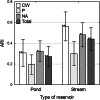High antagonistic activity and antibiotic resistance of flavobacteria of polar microbial freshwater mats on King George Island in maritime Antarctica
- PMID: 40253552
- PMCID: PMC12009332
- DOI: 10.1038/s41598-025-97205-x
High antagonistic activity and antibiotic resistance of flavobacteria of polar microbial freshwater mats on King George Island in maritime Antarctica
Abstract
This is the first study to demonstrate a relationship between antagonistic interactions with antibiotic resistance within flavobacterial strains, a component of polar-region microbial mats. These strains were derived from ephemeral freshwater reservoirs, i.e. ponds and streams of the periglacial zone of Ecology Glacier (King George Island, maritime Antarctica). The study demonstrated the strains' surprisingly high phylogenetic diversity, with 20 species among 50 isolates. Flavobacteria were characterised by different patterns of antagonism and sensitivity to antimicrobials. 29 strains produced substances inhibiting the growth of other isolates, with 21 strains being sensitive to such compounds; 34 strains were multidrug-resistant (MDR). The antibiotic resistance index (ARI) demonstrated a significantly higher proportion of MDR strains and ARI ≥ 0.2 in stream mats (87%) as compared to the strains derived from pond mats (55%). A strong correlation was observed between the strains' antagonistic potential and antibiotic resistance. An important role in these phenomena is accomplished by the "super bacteria" strains that effectively accumulate numerous traits associated with antagonistic potential and can be involved in the potential transfer of these traits. The results of the study demonstrate that there are individual patterns of antagonistic interactions and antibiotic resistance among the biotic components of mats.
Keywords: Antagonistic activity; Antarctica; Antibiotic resistance; Flavobacteria; Microbial Mats.
© 2025. The Author(s).
Conflict of interest statement
Declarations. Competing interests: The authors declare no competing interests.
Figures







Similar articles
-
Antibiotic resistance in bacterial isolates from freshwater samples in Fildes Peninsula, King George Island, Antarctica.Sci Rep. 2020 Feb 21;10(1):3145. doi: 10.1038/s41598-020-60035-0. Sci Rep. 2020. PMID: 32081909 Free PMC article.
-
Gillisia limnaea gen. nov., sp. nov., a new member of the family Flavobacteriaceae isolated from a microbial mat in Lake Fryxell, Antarctica.Int J Syst Evol Microbiol. 2004 Mar;54(Pt 2):445-448. doi: 10.1099/ijs.0.02922-0. Int J Syst Evol Microbiol. 2004. PMID: 15023957
-
Relationship between plasmid occurrence and antibiotic resistance in Myroides odoratimimus SKS05-GRD isolated from raw chicken meat.World J Microbiol Biotechnol. 2013 Jun;29(6):983-90. doi: 10.1007/s11274-013-1257-9. Epub 2013 Jan 12. World J Microbiol Biotechnol. 2013. PMID: 23315267
-
Antibiotic resistance mechanisms of Myroides sp.J Zhejiang Univ Sci B. 2016 Mar;17(3):188-99. doi: 10.1631/jzus.B1500068. J Zhejiang Univ Sci B. 2016. PMID: 26984839 Free PMC article. Review.
-
Freshwater environments as reservoirs of antibiotic resistant bacteria and their role in the dissemination of antibiotic resistance genes.Environ Pollut. 2019 Nov;254(Pt B):113067. doi: 10.1016/j.envpol.2019.113067. Epub 2019 Aug 21. Environ Pollut. 2019. PMID: 31465907 Review.
Cited by
-
Beyond the Usual Suspects: Weeksella virosa as a Potential Human and Animal Pathogen.Trop Med Infect Dis. 2025 Jul 26;10(8):210. doi: 10.3390/tropicalmed10080210. Trop Med Infect Dis. 2025. PMID: 40864113 Free PMC article. Review.
References
-
- Bernardet, J. F. & Bowman, J. P. Flavobacterium. In Bergey’s Manual of Systematics of Archaea and Bacteria. (eds Krieg, N. R. et al.) 10.1002/9781118960608.gbm00312 (Wiley & Sons, 2015).
-
- Králová, S. Role of fatty acids in cold adaptation of Antarctic psychrophilic Flavobacterium spp. Syst. Appl. Microbiol.40, 6. 10.1016/j.syapm.2017.06.001 (2017). - PubMed
-
- McCammon, S. A. & Bowman, J. P. Taxonomy of Antarctic Flavobacterium species: description of Flavobacterium gillisiae sp. nov., Flavobacterium tegetincola sp. nov., and Flavobacterium xanthum sp. nov., nom. rev. and reclassification of [Flavobacterium] salegens as Salegentibacter salegens gen. nov., comb. nov. Int. J. Syst. Evol. Microbiol. 50, 3. 10.1099/00207713-50-3-1055 (2000). - PubMed
MeSH terms
Substances
LinkOut - more resources
Full Text Sources
Medical

